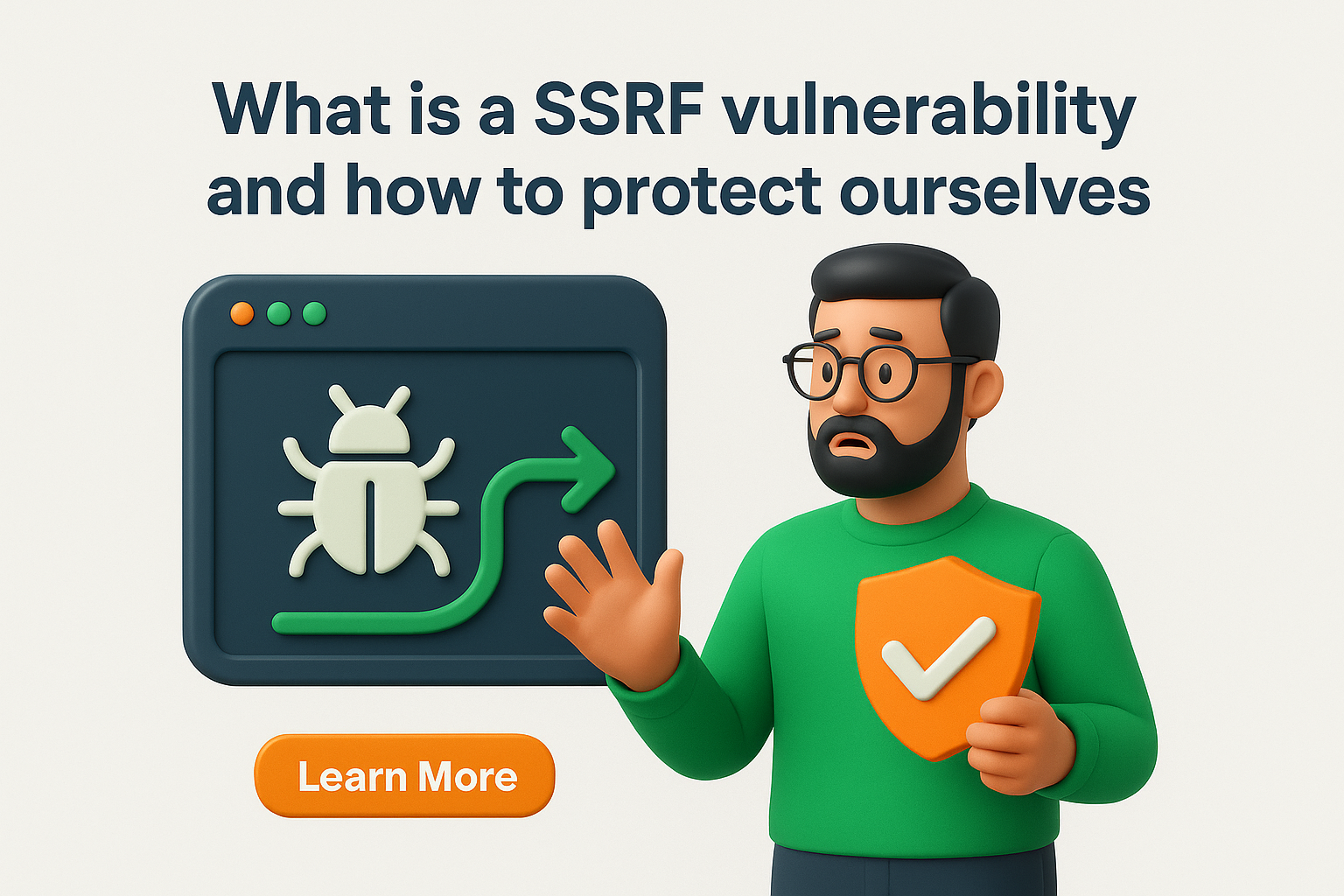The Ultimate Guide to SSRF, How a Simple Link Can Breach Your Entire Network.
In the world of cybersecurity, we often focus on protecting our applications from direct attacks, brute-force passwords, SQL injection, and cross-site scripting. But what if the most dangerous attack didn’t target your application directly, but instead used your application as a weapon against you?
This is the essence of a Server-Side Request Forgery (SSRF) vulnerability. It’s an often-overlooked flaw that can have catastrophic consequences, from leaking customer data to handing over the keys to your entire cloud infrastructure.
Let’s dive deep into what SSRF is, why it’s so dangerous, and exactly how you can build defences against it.
What is a Server-Side Request Forgery (SSRF) Vulnerability?
At its core, an SSRF vulnerability allows an attacker to trick a server into making unauthorized requests to an internal or external resource of the attacker’s choosing.
Think of your web application as a trusted employee with a master key (your server’s network access). This employee can freely access the office filing cabinet (internal databases), send mail to other branches (external third-party APIs), and talk to the security desk (cloud metadata services). An SSRF flaw is like an attacker tricking that employee to use their master key to open a door they shouldn’t.
The Technical Breakdown:
A typical web application often needs to fetch data from a URL provided by a admins . For example:
-
A feature that fetches a user’s avatar from a URL.
-
A webhook that processes data from a given endpoint.
-
A document parser that reads data from a supplied link.
In an SSRF attack, instead of a legitimate URL, an attacker submits a malicious one. The server, trusting the input, makes the request, and the attacker can now probe and interact with systems that were never meant to be exposed.
There Are Two Faces of SSRF: Classic and Blind
-
Classic SSRF: The server’s response is returned directly to the attacker. This allows them to see the data fetched from the internal service, making it easy to exfiltrate information.
-
Blind SSRF: The server makes the request, but the response is not returned to the attacker. While seemingly less dangerous, Blind SSRF can still be exploited for port scanning internal networks or triggering actions on internal services (like resetting a database).
Why is SSRF So Dangerous? The Real-World Risks
The severity of an SSRF vulnerability lies in its potential to bypass firewalls and security perimeters, turning a seemingly minor input flaw into a major breach.
Key risks include:
(1) Access to Internal Services: Attackers can scan and interact with internal networks, accessing systems like databases , administrative panels, or file shares that are not exposed to the public internet.
(2) Cloud Metadata Exposure: A particularly devastating attack vector. In cloud environments, a special internal endpoint provides the running instance with its own configuration data, including IAM credentials, security tokens, and user data. An SSRF can be used to steal these keys, leading to a complete compromise of the cloud account.
(3) Bypassing Authentication: If an internal service trusts requests coming from the application server (a common pattern in microservices architectures), an SSRF can be used to perform authenticated actions on those services without any credentials.
(4) Remote Code Execution (RCE): In the worst-case scenario, by interacting with internal services that accept dangerous commands, an attacker can chain an SSRF to achieve full RCE on the server.
(5) Request Abuse & Botnet Recruitment: Once an attacker controls where your server sends requests, they can abuse its resources and reputation.
-
-
Spam & Phishing Relays: Your server’s IP address can be used to send spam emails, phishing links, or malicious payloads, damaging your IP reputation and potentially getting your server blacklisted.
-
DDoS Participation: The attacker can use your server to make numerous requests to a target victim, effectively enrolling it in a Distributed Denial-of-Service (DDoS) botnet without your knowledge.
-
Port Scanning Other Networks: Your server becomes a proxy for the attacker to scan and attack external networks, making the malicious activity trace back to you.
-
How Does an SSRF Attack Happen? A Simple Example
Imagine a social media app with a “set profile picture by URL” feature.
-
A normal user inputs:
https://example.com/my-avatar.png -
The server fetches this image and saves it.
Now, an attacker inputs: file:///etc/passwd
The server, instead of fetching an external image, reads the local /etc/passwd file from its own filesystem and displays it as the “profile picture,” leaking sensitive system information.
How to Protect Your Applications from SSRF
Preventing SSRF requires a defence-in-depth strategy, combining input validation with network-level controls.
1. Implement an Allow list for Input
This is the most effective control. Instead of trying to block bad URLs, only allow URLs that match a predefined set of known-good domains or IPs. If your app only needs to fetch avatars from gravatar.com, your allow-list should reflect that.
2. Validate and Sanitize User Input
If an allow-list is too restrictive, perform strict validation on user input.
-
Schema Validation: Only allow
http://orhttps://schemes. Reject dangerous ones likefile://,ftp://,gopher://, anddict://. -
Block Reserved IP Ranges: Reject requests to private IP addresses (e.g.,
10.0.0.0/8,172.16.0.0/12,192.168.0.0/16) and the loopback interface (127.0.0.1). Remember to block IPv6 equivalents.
3. Use a Dedicated, Restricted HTTP Client
Don’t use a generic client. Configure a dedicated HTTP client for outgoing requests with critical security settings:
-
Enforce a Redirect Policy: Always resolve redirects on the server side and validate the final destination URL against your allow-list/blocklist. Attackers often use open redirects to bypass initial validation.
-
Set a Short Timeout: This limits the attacker’s ability to use the server for slow port scanning.
4. Segment and Harden Your Network
Assume a breach is possible and limit the potential damage.
-
Network Segmentation: Place application servers in a tightly controlled network segment with minimal access to internal resources. Use firewalls to block all internal traffic that isn’t explicitly required.
-
Cloud Metadata Protection: Use the latest versions of cloud metadata services , which require a header and are more resistant to simple SSRF attacks.
5. Use a URL Parser Library
Never use regex or custom parsing for URLs. Use a well-maintained, standard library for your programming language to properly parse and decompose URLs, preventing parsing bypass techniques.
Conclusion: Vigilance is Key
SSRF is a powerful and evolving threat that exploits the inherent trust a server has in its own network. By understanding how it works and implementing a layered defence of strict input validation, network segmentation, and secure application design, you can significantly reduce your risk and ensure your server remains an ally, not an attack vector. Make SSRF prevention a standard part of your code review and security testing processes.
Need help securing your applications against SSRF and other vulnerabilities? (Contact our security team at Support@wpwebgreen.com) for a comprehensive application security assessment.


